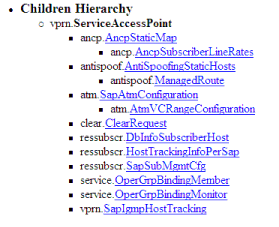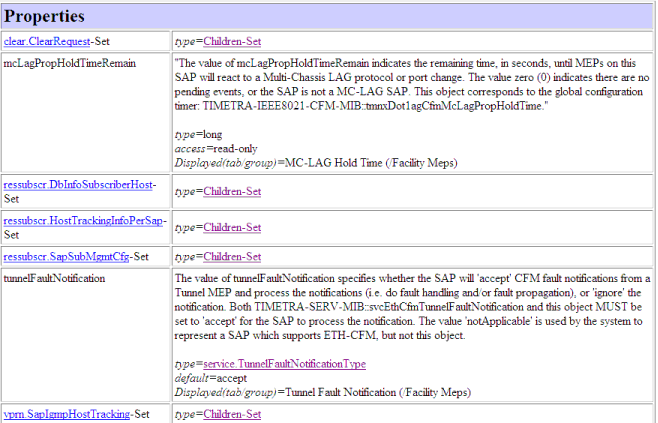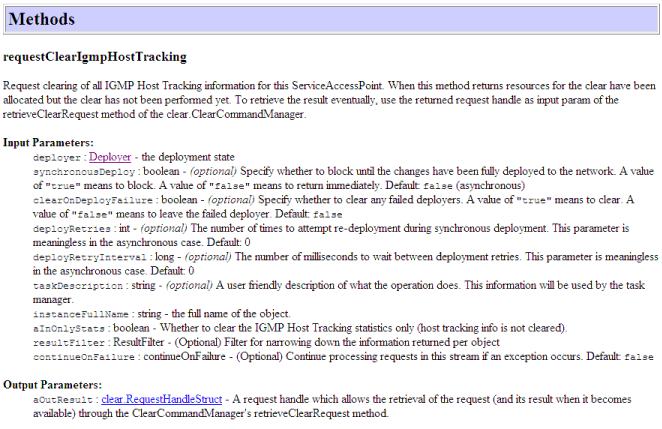Class details
Overview
Description
The description provides information about the selected class. For example:
vprn
ServiceAccessPoint
A Service Access Point identifies the customer interface point in a Routed CO VPRN solution.Inheritance hierarchy
The inheritance hierarchy outlines the inheritance tree with the list of all classes that are extended to define a class, as shown in the following figure.
Figure 8-2: Sample inheritance hierarchy

Direct subclass
The direct subclass lists all classes that inherit directly from the selected class, as shown in the following figure.
Figure 8-3: Sample direct subclass

Parent hierarchy
The parent hierarchy indicates where an instance of the class may be located in the containment hierarchy, as shown in Figure 8-4, Sample parent hierarchy .
The fully distinguished name, or objectFullName, specifies the NFM-P identifier for the specific object. See Schema Reference for more information about object full name.
Figure 8-4: Sample parent hierarchy

Children hierarchy
The children hierarchy lists the types of classes that may be contained in the hierarchy, for example, directly as children or indirectly as descendents, as shown in the following figure.
Figure 8-5: Sample children hierarchy

Relationships
The format of relationships displays the relationship between the current class and other classes. The textual description is of the form:
<current-class> may be <relationship-description> <cardinality> <other-class> (<relationship-type>)where
<relationship-description> is one of the following: associated with, direct parent of, direct children of, contained under, or contain
<cardinality> describes one or many
<relationships-type> is one of the following: parent-child, child-parent, implied, ancestor-descendent, or descendent-ancestor
The following figure shows an example of relationships.
Figure 8-6: Sample relationships

Class type
The class type is an abstract or a non-abstract class, which is defined as:
public [abstract] class nameAbstract classes are generally used to provide common property and method inheritance for concrete classes; for example, public abstract class Vll. The following is an example of a non-abstract class: public class serviceAccessPoint.
Naming
Objects are named by concatenating the parent and relative names. The relative name of an instance may be defined as: Relative Name=[name]. For example:
Relative Name=[svc-mgr]Class properties present in the name are identified as: ${propertyName}. For example:
Relative Name=[ospf-${version}-instance-${instanceIndex}]Auto-generated IDs are identified with an "*", such as in ${*propertyName}.
Methods that return children
Some methods return children and some methods do not return children. These methods are denoted with the description; for example:
methodName() does not return childrenFor example, for netw.NetworkElement:
Stats
The Stats section lists the set of classes that monitor the class, including inherited statistics classes. The following figure shows an example.
Figure 8-7: Sample stats

Stats for
The Stats for section lists the set of classes that the class monitors, as shown in the following figure.
Figure 8-8: Sample stats for

Supporting MIBs
The supporting MIBs section lists the MIB entries that the class reads and the supported device releases for each, as shown in the following figure.
Figure 8-9: Sample supporting MIBs

Properties
The properties are listed alphabetically list of properties displayed for each class. The property definitions may include:
-
type=type-specification— may be a fundamental type or link to another defined type. Children-Set indicates that objects of the specified type may be children of this class.
-
access=access-type—may be read-only, write-only, read-create, or read-write, which is the default. Read-create values can be set at creation time only.
-
Mandatory on create (Indicates the value is required when an object is created)
-
SNMP Deploy/Resync: MIB.entry—defined for read-write access to the NE
-
Modification may shutdown object—changing the value may shut down the object. The GUI displays a dialog box for these items.
-
Displayed (tab/group)=Displayed (tab/group)—displays the property name and tab location in the GUI. When a property does not have a tab or group information, the property is displayed in the general area.
-
enums=enumeration—lists the enumerations when they are defined in a property
The following figure shows an example.
Figure 8-10: Sample properties

Overridden properties
A list of all properties that are overridden in this class. A property may be partly overridden and partly inherited through several classes.
Properties inherited from
Inherited and overridden properties may exist with links to definitions in other classes. Properties that are overridden by a specific class are displayed in italics. The following figure shows an example.
Figure 8-11: Sample properties inherited from

Methods
A list of methods is displayed for each class. The method definitions may include:
The following figure shows an example.
Figure 8-12: Sample methods

Methods inherited from
There may be a list of inherited methods with links to definitions in other classes. The following figure shows an example.
Figure 8-13: Sample methods inherited from

Supported network elements
Supported network elements is a list of products and releases that support this class. Specifications may include:
-
excluded chassis types chassis-list—not supported for the specified variants of this product
-
supported from version—supported for this device for the specified and later releases; there can be multiple entries of this type
-
supported for all releases—supported for all device releases
If the supported network elements list does not appear, the class may be supported for any NE.
The following figure shows an example.
Figure 8-14: Sample supported network elements

Product specifics
Product specifics is a list of device- and release-specific properties, such as the following:
-
Excluded Chassis Types=chassis-list—list of chassis that do not support the property
-
Supported from=version—supported for the product for the specified and later device releases
-
access=access type—allowed configuration access, such as read-only, write-only, or read-create
-
write-access=yes | no—overrides the write access set using the access attribute in the base property